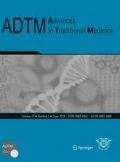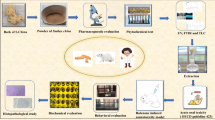Abstract
In the present study, the aqueous extract of Cynodon dactylon (AECD) Pers. (Graminae) was evaluated for anti-parkinson’s activity in rats. The anti-parkinson’s effect of AECD was studied against rotenone (2 mg/kg, s.c.) - induced parkinsons in rats. In this study, chronic administration of rotenone in rats (28 days) produced motor dysfunctions like catalepsy and muscle rigidity along with a reduction in locomotor activity. Rotenone administration was also found to generate oxidative stress in the brain as evident from an increase in the level of TBARS and decrease in the levels of SOD and GSH. Pretreatment with AECD resulted in a significant (p < 0.001) decrease in catalepsy and muscle rigidity along with a significant (p < 0.001) increase in locomotion as compared to the rotenone-treated control group. AECD treated rats also showed a reduction in the TBARS level and an increase in the GSH, SOD and CAT levels; thus reducing the oxidative stress in the brain of animals. The study thus proved that Cynodon dactylon treatment significantly attenuated the motor defects and also protected the brain from oxidative stress, both induced by rotenone. These results strongly indicate the possible therapeutic potential of Cynodon dactylon as an antioxidant in Parkinson’s disease and other movement disorders.



Similar content being viewed by others
References
Aebi H (1974) Catalase. In: Bergmeyer HU (ed) Methods of enzymatic analysis, 2nd edn. Chemic Academic Press, New York, pp 673–685
Agharkar SP (1991) Medicinal plants of Bombay Presidency. Scientific Publishers, Mumbai, pp 80–87
Alam M, Schmidt WJ (2002) Rotenone destroys dopaminergic neurons and induces parkinsonian symptoms in rats. Behav Brain Res 136:317–324
Auddy B, Ferreira M, Blasina F, Lafon L, Arredondo F, Dajas F, Tripathi PC, Seal T, Mukherje B (2003) Screening of antioxidant activity of three Indian medicinal plants, traditionally used for the management of neurodegenerative diseases. J Ethnopharmacol 84:131–138
Babu RDS, Neeharika V, Pallavi V, Reddy MB (2009) Antidiarrheal activity of Cynodon Dactylon. Pers Phcog Mag 5:23–27
Baskar AA, Ignacimuthu S (2010) Chemopreventive effect of Cynodon dactylon (L.) Pers. extract against DMH-induced colon carcinogenesis in experimental animals. Exp Toxicol Pathol 62(4):423–431
Betarbet R, Sherer TB, Greenamyre JT (2002) Animal models of Parkinson’s disease. Bioessays 24(4):308–318
Beutler E, Duron O, Kelly BM (1963) Improved method for the determination of blood glutathione. J Lab Clin Med 6:882–888
Bishnoi M, Chopra K, Kulkarni SK (2006) Involvement of adenosinergic receptor system in an animal model of tardive dyskinesia and associated behavioural, biochemical and neurochemical changes. Eur J Pharmacol 52(1–3):55–66
Bowler C, Van Montagu M, Inzé D (1992) Superoxide dismutase and stress tolerance. Annu Rev Plant Physiol Plant Mo1 Biol 4(3):86–116
Chen L, Ding Y, Cagniard B, Van Laar AD, Mortimer A, Chi W, Hastings TG, Kang UJ, Zhuang X (2008) Unregulated cytosolic dopamine causes neurodegeneration associated with oxidative stress in mice. J Neurosci 28(2):425–433
Collier TJ, Sortwell CE (1999) Therapeutic potential of nerve growth factors in Parkinson’s disease. Drug Aging 14:261–287
Costall B, Naylor RJ (1974) On catalepsy and catatonia and the predictability of the catalepsy test for neuroleptic activity. Psychopharmacologia 34(3):233–241
Dhanasekaran M, Tharakan B, Manyam BV (2008) Antiparkinson drug- Mucuna pruriens shows antioxidant and metal chelating activity. Phytother Res 22(1):6–11
Dexter DT, Carter CJ, Wells FR (1989) Basal lipid peroxidation in substantia nigra is increased in Parkinson’s disease. J Neurochem 52:381–389
Dexter DT, Holley AE, Flitter WD (1994) Increased levels of lipid hydroperoxides in the parkinsonian substantia nigra: an HPLC and ESR study. Mov Disord 9:92–97
Dorval J, Hontela A (2003) Role of glutathione redox cycle and catalase in defence against oxidative stress induced by endosulfan in adrenocortical cells of rainbow trout (Oncorhynchus mykiss). Toxicol Appl Pharmacol 192(2):191–200
Emborg ME (2004) Evaluation of animal models of Parkinson’s disease for neuroprotective strategies. J Neurosci Methods 139:121–143
Forno LS (1996) Neuropathology of Parkinson’s disease. J Neuropathol Exp Neurol: 259-272.
Garg VK, Paliwal SK (2011) Anti-inflammatory activity of aqueous extract of Cynodon dactylon. Int J Pharmacol 1-6.
Gorell JM, Johnson CC, Rybicki BA, Peterson EL, Richardson RJ (1998) The risk of Parkinson’s disease with exposure to pesticides, farming, well water, and rural living. Neurology 50:1346–1350
Gralla EB, Kosman DJ (1992) Molecular genetics of superoxide dismutases in yeasts and related fungi. Adv Genet 30:251–319
Grillner S, Kotaleski JH, Menard A, Saitoh K, Wikstrom M (2005) Mechanisms for selection of basic motor programs-roles for the striatum and pallidum. Trends Neurosci 28:364–370
Halegrahara N, Ponnusamy K (2010) Neuroprotective effect of Centella asiatica extract (CEA) on experimentally induced parkinsonism in aged Sprague-Dawley rats. J Toxicol Sci 35:41–47
Halliwell B, Gutteridge J (1985) Oxygen radicals and the nervous system. Trends Neurosci 8:22–29
Hauss-Wegrzyniak B, Dobrzanski P, Stoehr JD, Wenk GL (1998) Chronic neuroinflammation in rats reproduces components of the neurobiology of Alzheimer’s disease. Brain Res 780:294–303
Jenner P, Olanow CW (1998) Understanding cell death in Parkinson’s disease. Ann Neurol 44:S72–S84
Karch AM (2009) Focus on nursing pharmacology, 5th edn. Lippincott Williams & Wilkins, Philadelphia, p 3
Knight TR, Fariss MW, Farhood A, Jaeschke H (2003) Role of lipid peroxidation as mechanism of liver injury after acetaminophen overdose in mice. Toxicol Sci 76(1):229–236
Kulkarni SK (2008) Handbook of experimental pharmacology. Vallabh Prakashan, Delhi, pp 136–137
Kumar R, Bheemachari PM, Bansal R, Singh L (2010) Evaluation of antiepileptic activity of leaf extract of Cynodon dactylon in validated animal models. Int J Pharmacy Res 1(2):65–73
Lang AE, Lozano AM (1998) Parkinson’s disease. N Engl J Med 339:1130
Lapointe N, St-Hilaire M, Martinoli MG, Blanchet J, Gould CR, Cicchetti F (2004) Rotenone induces non-specific central nervous and systemic toxicity. FASEB J 18:717–719
Lotharius J, O’Malley KL (2000) The parkinsonism-inducing drug 1-methyl-4-phenylpyridinium triggers intracellular dopamine oxidation. A novel mechanism of toxicity. J Biol Chem 275:38581–38588
McGeer PL, Itagaki S, Boyes BE, McGeer EG (1988) Reactive microglias are positive for HLA-DR in the substantia nigra of Parkinson’s and Alzheimer’s disease brains. Neurology 38:1285–1291
Mizuno Y, Ohta S, Tanaka M, Takamiya S, Suzuki K, Sato T, Oya H, Ozawa T, Kagawa Y (1989) Deficiencies in complex-I subunits of the respiratory chain in Parkinson’s disease. Biochem Biophys Res Commun 163:1450–1455
Monk LS, Fagerstedt KV, Crawford RM (1989) Oxygen toxicity and superoxide dismutase as an antioxidant in physiological stress. Physiol Plant 76:456–459
Najafi M, Nazemiyeh H, Ghavimi H, Gharakhani A, Garjani A (2008) Effects of hydroalcoholic extract of Cynodon dactylon (L.) pers. on ischemia/reperfusion-induced arrhythmias. DARU 16(4):233–238
Ohkawa H, Ohishi N, Yagi K (1979) Assay for lipid peroxides in animal tissues by thio-barbituric acid reaction. Anal Biochem 95:351–358
Pal DK (2009) Determination of brain biogenic amines in Cynodon dactylon pers. and Cyperus rotundus treated mice. Int J Pharmacy Pharm Sci 1(1):190–197
Parekh J, Chanda SV (2007) In vitro antimicrobial activity and phytochemical analysis of some Indian medicinal plants. Turk J Biol 31:53–58
Parekh J, Jadeja D, Chanda S (2005) Efficacy of aqueous and methanol extracts of some medicinal plants for potential antibacterial activity. Turk J Biol 29:203–210
Pati AK (2010) Cynodon, Durba Grass, An Ayurvedic Medicinal Grass Grown In India (Press release).
Patil M, Jalalpure SS, Prakash NS, Kokate CK (2005) Anti ulcer properties of Cynodon dactylon extracts in rats. Acta Horticulturae 680:115
Rai PK, Jaiswal D, Rai DK, Sharma B, Watal G (2010) Antioxidant potential of oral feeding of Cynodon dactylon extract on diabetes-induced oxidative stress. J Food Biochem 34:78–92
Samantaray S, Knaryan VH, Guyton MK, Matzelle DD, Ray SK, Banik N (2007) The parkinsonian neurotoxin rotenone activates calpain and caspase-3 leading to motoneuron degeneration in spinal cord of Lewis rats. Neuroscience 146(2):741–755
Santhi R, Annapoorani S (2010) Efficacy of Cynodon dactylon for immunomodulatory activity. Drug Invention Today 2(2):112–114
Saravanan KS, Sindhu KM, Senthilkumar KS, Mohanakumar KP (2006) L Deprenyl protects against rotenone-induced, oxidative stress mediated dopaminergic neurodegeneration in rats. Neurochem Int 49:28–40
Saravanan KS, Sindhu KM, Mohanakumar KP (2007) Melatonin protects against rotenone-induced oxidative stress in a hemiparkinsonian rat model. J Pineal Res 42(3):247–253
Scandalios JG (1990) Response of plant antioxidant defense genes to environmental stress. Adv Genet 28:1–41
Schmidt WJ, Alam M (2006) Controversies on new animal models of Parkinson’s disease pro and con: the rotenone model of Parkinson’s disease (PD). J Neural Transm 70:273–276
Scott L (2006) Identifying poor symptom control in Parkinson’s disease. Nurs Times 2:30–32
Shabi MM, Gayathri K, Venkatalakshmi R, Sasikala C (2010) Chemical Constituents of hydro alcoholic extract and phenolic fraction of Cynodon dactylon. Int J Chem Tech Res 2(1):149–154
Neha S, Rana AC, Bafna PA (2011) Effect of aqueous extract of Cynodon dactylon on reserpine induced catalepsy. Int J Pharmacy Pharm Sci 3(4):424–426
Sherer TB, Betarbet R, Greenamyre JT (2002) Environment, mitochondria and Parkinson’s disease. Neuroscientist 8:192–197
Sherer TB, Betarberbet R, Tasta CM, Seo BB, Richardson JR, Kim JH, Miller GW, Yagi T, Yagi AM, Greenamyre JT (2003) Mechanism of toxicity in rotenone models of Parkinson’s disease. J Neurosci 23(340):10756–10764
Sherer TB, Richardson JR, Testa CM, Seo BB, Panov AV, Yagi T, Matsuno-Yagi A, Miller GW, Greenamyre JT (2007) Mechanism of toxicity of pesticides acting at complex 1: relevance to environmental etiologies of Parkinson’s disease. J Neurochem 100(6):1469–1479
Shivalinge Gowda KP, Satish S, Mahesh CM, Kumar V (2009) Study on the diuretic activity of Cynodon dactylon root stalk extract in albino rats. Res J Pharm Tech 2(2):338–340
Singh SK, Kesari AN, Gupta RK, Jaiswal D, Watal G (2007) Assessment of antidiabetic potential of Cynodon dactylon extract in streptozotocin diabetic rats. J Ethnopharmacol 114(2):174–179
Spillantini MG, Schmidt ML, Lee VM, Trojanowski JQ, Jakes R, Goedert M (1997) Alpha-synuclein in Lewy bodies. Nature 388:839–840
Surendra V, Prakash T, Sharma UR, Gohl D, Fadadul SD, Kotresha D (2008) Hepatoprotective activity of aerial parts of Cynodon dactylon against CCl4- induced in rats. Phcog Mag 4:195–201
Verma R, Nehru B (2009) Effect of centrophenoxine against rotenone-induced oxidative stress in an animal model of Parkinson’s disease. Neurochem Int 55:369–375
Wang HD, Pagano PJ, Du Y, Cayatte AJ, Quinn MT, Brecher P, Cohen RA (1998) Superoxide anion from the adventitia of the rat thoracic aorta inactivates nitric oxide. Circ Res 82:810–818
Wooten GF (1997) Neurochemistry and neuropharmacology of Parkinson’s disease. In: Watts RL, Koller O (eds) Movement disorders; neurologic principles and practice. McGraw Hill, New York, pp 153–160
Yang SF, Yangk ZQ, Wu Q, Sun AS, Huang XN, Shi JS (2001) Protective effect and mechanism of Ginkgo biloba leaf extracts for Parkinson’s disease induced by 1-methyl-4-phenyl-1, 2, 3, 6-tetrahydropyridine. Acta Pharmacol Sinica 22(12):1089–1093
Yong R, Liu RW, Jiang H, Jiang Q, Feng J (2005) Selective vulnerability of dopaminergic neurons to microtubule depolymerization. J Biol Chem 280(40):34105–34112
Zigmond MJ, Stricker EM (1989) Animal models of parkinsonism using selective neurotoxins: clinical and basic implications. Int Rev Neurobiol 31:1–79
Zoccarato F, Toscano P, Alexandre A (2005) Dopamine-derived dopaminochrome promotes H2O2 release at mitochondria complex-1. J Biol Chem 280(16):15587–15594
Acknowledgement
The authors would like to thank The Director, Rayat Institute of Pharmacy (Punjab) for providing the necessary facilities for the research work. The authors would also like to thank Chemical Resources, Panchkula (H.R.) and Amsar Pvt. Ltd., Indore (M.P.) for providing gift samples of drugs.
Author information
Authors and Affiliations
Corresponding author
Rights and permissions
About this article
Cite this article
Sharma, N., Bafna, P. Effect of Cynodon dactylon on rotenone induced Parkinson’s disease. Orient Pharm Exp Med 12, 167–175 (2012). https://doi.org/10.1007/s13596-012-0075-1
Received:
Accepted:
Published:
Issue Date:
DOI: https://doi.org/10.1007/s13596-012-0075-1




